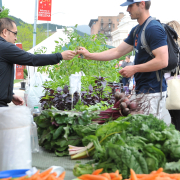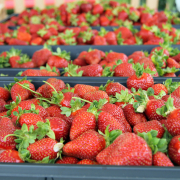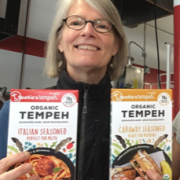Report: Montana-Grown Foods Account for $160 Million in Local Sales
The Grow Montana Food Policy Coalition has released a new report showing locally grown and sold foods make a big impact to Montana communities. The report, “Economic Value and Impact of Local Food in Montana,” was completed by Highland Economics on behalf of the coalition. It shows locally grown Montana foods supports $158 million in retail sales across the state’s economy. The report evaluates the economic value of “local food,” food produced and consumed in the state of Montana without leaving the state for finishing and processing elsewhere. The full report can be found at GROWMT.ORG.
“The study delivers a comprehensive look at the Montana food value chain,” says Jan Tusick, Director at Mission Mountain Food Enterprise Center, in Ronan and member of Grow Montana’s steering committee. “The study will be a critical tool as we continue to build local food economies and the economic benefit to our Montana communities.”
Highland Economics began research in January of 2021, and interviewed local food consumers, producers, and intermediaries (processors and institutional buyers such as schools and hospitals) to understand the current climate of local food purchasing in the state. An extensive literature review on local foods in Montana and nationwide was also conducted.
Key Takeaways Include:
- $158 million is the estimated total of retail value of local food sales in Montana: $118 million comes from sales at stores, restaurants institutions, and processors. Direct-to-consumer sales, such as farmers markets, farms-stands, and community supported agriculture (CSAs) subscriptions account for $40 million in local food sales.
- Local food production in Montana supports 1,110 Montana jobs and supports $31.9 million in Montana labor income.
- Less capacity to process food in Montana: Montana employed 3,000 people in the food-processing sector in the 1950s and while the population has doubled there are only 2,647 people employed in this sector today (2021).
- More reliance on processing outside the state and distribution infrastructure: This is particularly evident in meat processing. Montana is known for animal production, cattle in particular. Even though the state has the third highest ratio of cattle to people across the U.S. most of the meat consumed in the state is imported (or re-imported) after it is finished and processed elsewhere.
- A smaller share of the retail spending on food goes back to the farm and ranch: The farm and ranch share of the food dollar spent by consumers in 1910 was 60 percent, and today it is estimated at 16 percent.
“This report establishes an important and updated baseline for local food production and consumption in Montana,” says Maura Henn, Community Food Systems Specialist at National Center for Appropriate Technology and coordinator for Grow Montana. “Coalition members have seen on-the-ground evidence that there is less processing in state, a reliance on out-of-state processing, especially for beef, and that local farmers are getting less money for what they produce. Now we have numbers to support what we suspected, and this helps us see what is possible in terms of moving the needle toward increasing local food sales and consumption.”
In fact, the demand for local food is trending up nationally and in Montana. Sales of local edible farm products totaled nearly $12 billion in 2017 across the U.S., up from $8.7 billion in 2015. Specifically, in 2021 Montana farmers markets received $17.3 million in revenue and generated an additional $10.4 million in new spending from resident wages, tax payments, sales, and investments that occurred as a result of farmers markets.
“Visit any farmers market in the state where Dixon Melons are set up for the day,” says Henn, “and you will see the demand for local food is real! People line up around the block for a chance to buy fresh food direct from the farmer.”
Strong local food systems also provide the diversified safety net that is essential to avoid food insecurity. Current events such as the COVID-19 pandemic, war in Ukraine, and extreme weather events demonstrate that disruptions in a highly consolidated food system will create immediate backlogs and bottlenecks to either access or the supply of food.
Grow Montana’s next steps for this study are to share the results with local communities and conferences and to get feedback on the results from Montanans. The community input and the results of the study will help the coalition develop goals and policy priorities for future legislative sessions.
-30-
GROW MONTANA established in 2005, is a broad-based food policy coalition whose common purpose is to promote community economic development and education policies that support sustainable Montana-owned food production, processing, and distribution, and that improve all our citizens’ access to healthy Montana foods. Grow Montana is coordinated by NCAT. The coalition’s steering committee is: Alternative Energy Resources Organization (AERO), Community Food & Agriculture Coalition (CFAC), Land to Hand Montana, Mission West Community Development Partners, Montana Cooperative Development Center (MCDC), Montana Farmers Union (MFU), National Center for Appropriate Technology (NCAT), Northern Plains Resource Council (NPRC).
THE NATIONAL CENTER FOR APPROPRIATE TECHNOLOGY has been helping people build resilient communities through local and sustainable solutions that reduce poverty, strengthen self-reliance, and protect natural resources since 1976. Headquartered in Butte, Montana, NCAT has six regional offices in Arkansas, California, New Hampshire, Mississippi, Montana, and Texas. Learn more and become a friend of NCAT at NCAT.ORG.

 NCAT
NCAT

 NCAT
NCAT NCAT
NCAT